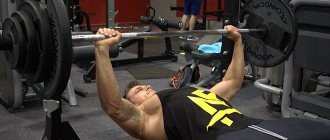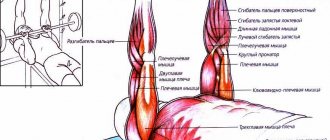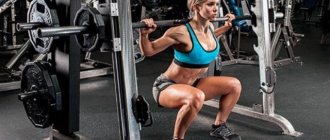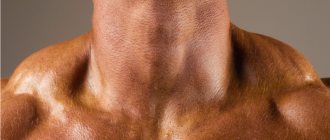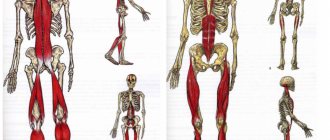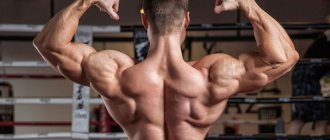To impress everyone with your excellent athletic form, you must know how to pump up your upper chest at home.
This will not only look aesthetically attractive, but will also generally strengthen the body.
Each gym has the necessary sports equipment that will help you quickly pump up all muscle groups.
These include: Bench. Barbell. Dumbbells. Other simulators.
But most people don't have the opportunity to go to gyms.
This happens for various reasons. For example, you are confused by the cost of a subscription or simply don’t have enough time.
Therefore, you definitely need to know how to exercise at home so that the muscles in the upper chest are pumped quickly and correctly.
Anatomy
Before you learn how to pump up your upper chest, you need to understand the anatomy of this muscle group. Anatomically, the muscles of the chest are divided into the following subgroups:
- superior (clavicular);
- average;
- lower (abdominal).
Many regulars of fitness centers and gyms often ignore exercises for the clavicular region of the chest, focusing on the sternocostal and abdominal regions, which respond better to the load and allow you to perform bench presses with heavier weights. But any professional athlete will tell you that for harmonious breast development it is necessary to combine exercises for all three parts of this muscle group.
In addition, it is worth understanding that the upper region of the pectoral muscles is the smallest, so it is more difficult to work it than the lower and middle ones. It receives indirect load during the performance of many classic exercises (for example, when bench pressing a barbell or dumbbells), but this load is often not enough for full development. As a result, in almost all cases we can see a disproportion: the middle and bottom are quite voluminous and massive, and the top looks underdeveloped against their background.
Training plan
In fact, the exercises presented are a ready-made training plan. They need to be performed sequentially, in one workout. If the overall load is not enough, you can supplement the training with deltoids, biceps or triceps.
It is not recommended to combine with exercises for the lower chest area. This is explained by the fact that they are very similar, the only difference is the inclination of the bench when pressing and the position of the body during push-ups. Thus, it is better to devote one workout a week to working only the upper part, and load the rest of the muscles in this area on another day.
Features of upper chest training
Every novice athlete should understand that the upper chest works only when the body is tilted more than 30 degrees and less than 60 degrees. For these purposes, it is best to use a special bench on which you can adjust the required position. If the angle of inclination is less than 30 degrees, then most of the load will be “eaten up” by the middle part of the chest, and if it is more than 60 degrees, then the deltoid muscles will actively participate in the work. The most optimal when working the upper bundle of the pectoral muscles is an inclination angle of 45 degrees.
Features of training for women and men
When developing programs for sports, women need to take into account the characteristics of their body and the specifics of muscle growth. The body is prone to storing fat. It is more difficult for them to increase muscle mass. This fact cannot be ruled out even among professional athletes.
The bulk of adipose tissue is located below the waist. The leg power of young women is 27% weaker than that of men. The shoulder girdle is inferior in endurance by 40-70%. The spine is longer, the limbs are shorter. The heart is smaller than a man's, so it contracts more often.
It takes the female body much more time to restore performance and well-being after heavy physical exertion, while men tolerate it much more easily.
The number of muscle fibers in the chest muscles is inferior to that of the opposite sex.
It is more difficult for girls to achieve an increase in muscle mass in this area, even with intense strength training. The difference between the training program for the fairer sex is the technique of performing the exercises, the rhythm and number of repetitions for a specific muscle group.
Female muscles are composed of smooth muscles. It is characterized by:
- weak ability to increase;
- endurance;
- minimal damage.
Taking these features into account, the size of the load and the number of repetitions in the approaches are calculated. Girls need to perform exercises, increasing the number of repetitions by 30% from those performed by men, using a light load.
Don't miss the most popular article in the section: Body drying for girls. Training program, detailed nutrition menu for the month by day.
How to pump up the upper pectoral muscles? Tips from a pro
The famous bodybuilder Gunter Schlerkamp has always been a fan of harmoniously developed chest muscles. The famous bodybuilder believes that in order to fully develop the upper pectorals, they need to be trained as seriously as other muscle groups. Here are some tips from Günther Schlerkamp for pumping up your upper torso:
- Start your training session with incline presses. You can perform the movements with a barbell, dumbbells, or a Smith machine. By starting your workout with an exercise on an incline bench, you will “catch” the lagging bundles of pectoral muscles fresh. This will allow you to lift heavier weights, which in turn will trigger muscle building processes in your body. Then you can move on to flat and incline bench exercises.
- Don't neglect dumbbells. Using these implements, you get a completely different load than with a classic barbell press, since the mechanics of the movement change dramatically.
- Do dumbbell flyes. Dumbbell flyes on a bench at a 45-degree angle are one of the best ways to not only build muscle in the upper chest, but also to define the muscles in more detail.
How to make the upper section work?
From all of the above, we can conclude that to pump up the upper chest, you need to perform exercises where your arms are raised higher than perpendicular to the body.
Among the exercises for the upper pectoral muscles can be various presses and flyes on a bench or hammer with a positive inclination of approximately 30-45 degrees .
The main thing here is not to overdo it. The larger the angle, the more deltas are involved in the work, and this is not exactly what we need.
It is also worth noting that the upper part of the pectoral muscles is its most stubborn section, so in order to pump it up, you will have to show persistence.
Imagine that you are a fat sixth grader wearing glasses with lenses the size of a telescope and you are trying to conquer the beautiful Masha from a parallel class. She constantly refuses you, but you don’t give up, you don’t give up trying day after day, week after week, and with incredible persistence you continue to try and do them more persistently. And so Masha gives in to your pressure and goes on a date with you. After this, the whole class begins to consider you a real man and looks at you with respect.
The same goes for training the upper pectoral muscles. If you have achieved an impressive result with your perseverance and now you can rest your chin on them when your neck gets tired, then all the jocks around you will certainly begin to respect you.
Incline barbell press
We've sorted out the theory, now let's talk about how to pump up your upper chest with exercises in the gym. We'll start with the incline barbell press. This movement is aimed at working the outer part of the upper chest.
- Take the starting position: sit on an incline bench, grab the barbell with such a grip that a 90-degree angle is formed between your forearm and shoulder.
- As you exhale, lower the barbell slowly and under control until it touches your upper chest.
- As you inhale, press it up.
- Repeat the movement 8-10 times. In total you need to do 3-4 approaches.
With heavy weights, it is advisable to use a partner who will help remove the bar from the racks and provide backup if something happens.
If you want to know what this exercise looks like in dynamics, then check out the video below.
Incline Dumbbell Press
The dumbbell press on an incline bench is performed according to the same principle as the previous exercise. As with many dumbbell exercises, the total weight lifted will be less than a similar barbell exercise because the lifter has to work hard to keep his arms from flailing in different directions.
In the previous exercise, the role of the partner is insignificant and consists, as a rule, in helping to remove a heavy apparatus from the racks or lift the barbell in a critical situation, and then help put it back on the racks. In the dumbbell press the opposite is true. Heavy and bulky shells are sometimes simply impossible to lift alone. That is why it is better to use the help of a belayer (and in some cases, two belayers) who can hand you your dumbbells.
When performing a dumbbell press, you need to understand that the range of motion in this exercise will be greater. Therefore, it is worth doing it extremely carefully.
Technique:
- Pick up the shells yourself or with the help of a partner. They should be held at approximately shoulder level.
- As you exhale, press the dumbbells up.
- Inhaling, slowly and slowly, feeling the stretch in your chest, lower them to the lowest point.
- Do 3-4 sets of 8-10 reps.
How to pump up a man's chest? Training video on pumping up the upper pecs using dumbbell flyes:
Correct technique for performing each exercise
Before training, do not forget to warm up and pre-stretch!
Barbell bench press
We will need an incline bench, barbell racks and the barbell itself. The exercise can be done at home. Here the weights are not as heavy as in the case of the classic bench press.
The first approach will be a warm-up with an empty bar (its weight is about 20 kg - for girls this is a lot, for guys it’s just right):
- Set the inclination of the bench back to 30 degrees. We lie down so that the barbell is exactly above our eyes.
- We grab the bar with our hands wider than our shoulders. The grip width is determined as follows: lower your arms from this position with your elbows down, the angle between the forearm and shoulder should be about 90 degrees. The grip is circular, there is no need for any one-sided grips where the bar could roll onto your stomach.
- We rest our feet on the floor. Raise the bar to the maximum possible straightening of your arms and lower it onto your neck. It was a breath.
- As you exhale, return it to the top point. Do 15 reps with an empty bar, then begin working sets.
If you are a girl, take a lighter bar. For you, dear ladies, there will always be bars weighing 4, 6, 8 kg, etc. They are rubberized and multi-colored.
The nuances that cause errors to occur:
- Do not lift your pelvis during the exercise. He is “glued” to the bench.
- The chest is slightly curved forward, there is a natural deflection in the lower back. There is no need to do any bridges, otherwise you will turn your body into the classic press position. The meaning of the tilt is lost.
- The legs are spread and the heels rest on the floor. It happens that beginners, having watched enough strange video tutorials on “how to build muscles,” keep their legs suspended. At any moment they can fall to one side of the bench. We understand that they also want to pump up their abs, but this is done separately. Without a barbell.
- We perform it smoothly, without jerking.
- Lower the barbell to the neck area. Not on the chin or chest. It is important for us to work the upper part of our pectoral muscles!
- We don’t take our heads off the bench. We look up, not left and right.
- Always lock the barbell. If during training the pancake falls or slides onto the edge of the bar, the approach will be wasted.
We select the working weight so that it is hard to work, only in this case we will be able to pump up something. We do this version of the exercise after the classic bench press, or on our own - 3-4 sets of 8-10 repetitions. We approach working weight gradually. If necessary, we call a partner to back up.
Dumbbell flyes
We set the same angle of the bench. We lie down on it in the same way as when doing a barbell press:
- The movement of dumbbells occurs in a plane perpendicular to the floor. Elbows point down.
- We stretch as much as possible, lowering our arms with dumbbells.
- The arms are slightly bent during the movement and almost straighten at the top point (there is no need to bend them to 90 degrees; you cannot do the exercise with straight arms).
We spread our hands as we inhale, and bring them together as we exhale. The weight should be such that you can do 3 sets of 12 reps with correct technique.
Dumbbell press
This is where disagreements arise. Some trainers suggest doing the same thing as with a barbell, but with dumbbells. Others say that you need to move your elbows a little closer to the body to increase the load on the front deltoids.
We offer a compromise: Move your elbows a little closer to your body from your angled bench press position. We do 3-4 sets of 10 times.
Bringing hands together in crossover
Perhaps the most technically difficult exercise:
- We install the necessary handles so that it is comfortable to hold with your hands.
- We stand between them. We take the handles with our palms forward and bring them together on slightly bent arms at chest level.
- Here is the nuance - if you lower your arms, it will no longer be the top of the pectoral muscles that will work.
- Your hands should be slightly behind each other at the final point of reduction, as if you had crossed them.
The exercise is a little easier than the version with dumbbells, so here you can perform a little more repetitions - 3-4 sets of 10-12 times.
Dips
The warm-up approach should be without weight. If possible, move the bars so that the distance between them is about 10 cm wider than your shoulders on each side.
The nuance is this: when doing push-ups, we do a “boat”. That is, we tilt our legs back. When moving from bottom to top, you seem to emerge from under the water. This will shift the load from below to the middle of the chest.
We do 3-4 approaches of 15 times without weight or the same number of approaches, but 8 repetitions with weights. If desired, you can make a ladder, reducing the number of repetitions from approach to approach, and increasing the weight.
Upside down push-ups
The most convenient option for breast lifting at home. Take a stool or sofa. We take a lying position, hands slightly wider than shoulders, fingers pointing forward. We put our feet on a stool.
This way you are standing in an inclined position. Head below feet. We do 3-4 sets of 10-15 times. If you can do more, do it. It doesn’t matter, it’s still without any burden.
We go down as we inhale, we rise as we exhale. Our chin almost touches the floor.
Incline Dumbbell Flyes
Many professional athletes recommend using this exercise as a “finisher” after incline presses. Since the fly is done at the end of the chest workout, the weight of the dumbbells should be less than what you used during the press.
- Take the starting position: the projectiles should be at the top in front of you, and your arms should be slightly bent at the elbow joint.
- Inhaling, spread the dumbbells out to the sides, feeling the stretch as much as possible.
- As you exhale, lift them to their original position.
Exercises on the horizontal bars
Working on the bars allows you to reduce weight, maintain the condition of the spine, strengthens the chest muscles, arm ligaments and joints . The projectile is complex. The technique of “negative repetitions” has been created for beginners. It is based on an allegedly already performed pull-up.
The person performing the exercise stands on a chair and fixes the position on the bar: arms are bent at the elbows, chin is raised above the bar (as if doing a pull-up). The chair is removed and the torso is slowly lowered on its own, arms are extended. The first week, perform 4-5 approaches, each with 3 repetitions.
When regular pull-ups become feasible, move on to more complex training:
- close grip with chest touching the bar;
- Pull-ups by the head with a wide grip. At the same time, keep your back straight, movements are smooth;
- lifting the body with a reverse grip, fingertips pointing at the trainee;
- hanging with legs raised, knees bent (increases height, straightens posture);
- lifting straight legs with flexion of the hips (pumps the abs).
Don’t miss the most popular article in the section: Glutamic acid - what it is, why and how it is used in sports and bodybuilding.
How to pump up your upper chest at home?
You already know how to train your upper pectoral muscles in the gym. But what about those people who do not have additional equipment? Or for those who can't afford a gym membership? If you are one of them, then don’t worry, there is a way out!
A good exercise to train your upper chest at home is incline push-ups. They are performed according to the same principle as classic push-ups, but the only difference is that in this variation the legs should be above shoulder level. To do this, you need to place your lower limbs on a stool, sofa or any other elevated surface. It is important to understand that if you do a lot of push-ups, you will develop endurance, not muscle mass and strength. In order for your muscles to grow, progression of loads is necessary. If you are already a more or less experienced athlete who can do several dozen high-quality push-ups without any problems, then you can start training with additional weights. This could be a regular backpack filled with books, water bottles, etc.
Sample program
Without an incline bench, barbell and dumbbells, it is quite difficult to pump up the upper pectoral muscles at home. You can only strengthen your upper chest through various push-ups with leg raises. Therefore, we recommend training in the gym. Here's an example of a workout plan focusing on the upper pecs.
- Warm-up: cardio (5-7 minutes) + warming up the arm joints.
- Classic full chest bench press (3-4/8-12).
- Incline dumbbell flyes (3-4/12-15).
- Incline barbell press (3-4/8-12).
- Reduction of hands in a crossover from the lower block (3-4/12-15).
- Platform push-ups (feet above head) (3-4/12-15).
To pump up the upper chest, it is enough to perform this program once a week. For athletes whose chest lags too much, it is permissible to train 2 times a week, but then the gap between classes should be at least 3-4 days. The training plan is designed for 8-10 weeks. Then it should be changed.
Exercises for the entire chest at home?
It should be noted right away that pumping up your breasts at home without additional equipment is a difficult task, but not impossible. In the last section, we gave an example of an exercise that is a good alternative to the incline bench press. Below we will attach a video that shows the best and most effective exercises for all areas of the chest at home.
Videos can be a good help in training, especially if they are educational. How to pump up a man's chest at home? This video will help you understand the issue.
Recommendations for beginning athletes
You already know how you can pump up your upper pectoral muscles at home or in the gym. Below are some important tips that will help you achieve your desired results faster.
- Don't train your chest too often. One of the most common mistakes among beginners is training too often. Beginning athletes naively believe that the more often they exercise, the faster their muscle mass will grow. In fact, this approach will not only not speed up muscle growth, but, on the contrary, will slow it down significantly. In order for your pecs to grow and your working weights to increase, you need to recover. This applies not only to the pectoral muscles, but also to the muscles of the whole body.
- Breathe correctly. Breathing is an important training aspect that will determine how many repetitions you can do in one set. Remember that in the positive phase of the exercise you need to exhale, and in the negative phase you need to inhale.
- Pay attention to technology and safety. Before you start doing any exercise that is new to you, study its technique in detail. If you feel that the selected working weight is very difficult for you, reduce it to avoid injury. Remember to warm up thoroughly before each training session to prepare your muscles and joints for subsequent strength loads.
Anatomy of the pectoral muscles
The chest muscles are one of the largest muscle groups in humans, located on the outer surface of the thoracic region. Their structure is fan-shaped and consists of 3 main muscle bundles
The chest muscles are one of the largest muscle groups in humans, located on the outer surface of the thoracic region. Their structure is fan-shaped and consists of 3 main muscle bundles.
Main functional features
The pectoralis major muscle is responsible for lowering the arm from the top position directly to the body. At the same time, she makes a simultaneous rotation of the arm towards the inside of the body. The large lever allows you to make the above movement powerful, fast and strong, which is exactly what is needed for heavy chest training.
The pectoralis minor muscle is shaped like a flat triangle and is located under the main muscle. It begins in the area of the ribs and is attached directly to the shoulder blade.
The main functional feature is aimed at moving the scapula and pulling it back and forth.
The serratus anterior is located lateral to the front of the pectoralis muscle, which originates from the ribs and inserts at the scapula.
The subclavius muscle is located directly in the collarbone area.
The main functional activity of the anterior muscle is aimed at rotating and moving the scapula forward. The second muscle has one function - it moves the collarbone down.
There are two types of intercostal muscles: internal and external. They are attached to different parts of the ribs: this is necessary to ensure the normal process of exhalation and inhalation.
The hypochondrium muscles are attached to the inside of the lower ribs. The main difference from the intercostal muscles is the uneven and less frequent attachment of muscle bundles.
The diaphragm is a muscular structure responsible for human breathing. It is movable, consisting of a septum that is located between the cavities of the chest and abdomen.
Functional features:
When the diaphragm contracts, the chest plane moves away and increases, and the abdominal plane decreases accordingly. The above action is accompanied by a person’s inhalation.
Contraction of the abdomen and diaphragm increases intra-abdominal pressure. This integral physiological characteristic is very important when working with extreme weights.
What should be noted from all of the above?
- First, the chest muscles are unique in their physiology and genetic predisposition to growth. The muscle fibers of the chest are located in different directions. That is why it is necessary to train the chest from different angles.
- Secondly, the chest muscles are a large muscle group, so they are able to work in strength mode and tolerate high-intensity training.

